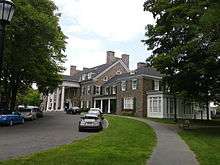Fenimore Art Museum
 The Fenimore Art Museum building, seen in July 2014 | |
| Established | 1899 |
|---|---|
| Location | Cooperstown, New York |
| Coordinates | 42°42′56.4″N 074°55′37″W / 42.715667°N 74.92694°W |
| Type | Art museum |
| President | Dr. Paul D’Ambrosio |
| Website |
www |
The Fenimore Art Museum (formerly known as Fenimore House Museum) is a museum located in Cooperstown, New York, United States, operating under the auspices of the New York State Historical Association. It presents changing and permanent exhibitions of American Folk Art, North American Indian art and artifacts, Hudson River School and 19th-century genre paintings, and American photography.
The Museum was moved to its present location — Cooperstown, New York overlooking Lake Otsego — in 1939 due to a gift from Stephen Carlton Clark. Much of the American Fine Art Collection was donated by Clark, a generous art connoisseur.
The museum also has a great deal of material associated with James Fenimore Cooper, Cooperstown's most famous native son, and his family. This includes furniture, portraits and paintings, personal effects and books owned by Cooper, as well as manuscripts and first editions of his writings.
The Fenimore Art Museum is closely associated with The Farmers' Museum, also in Cooperstown.
History
Fenimore Art Museum's parent organization, the New York State Historical Association, was founded in 1899 by five New Yorkers interested in promoting a greater knowledge of the early history of the state. They hoped to encourage original research, to educate general audiences by means of lectures and publications, to mark places of historic interest, and to establish a library and museum to hold manuscripts, paintings, and objects associated with New York State. From 1926 until 1939, the Association’s headquarters was in Ticonderoga, New York in a facsimile of John Hancock’s house in Boston.
In 1939, Stephen Carlton Clark offered the Association a new home in the village of Cooperstown. Clark took an active interest in expanding the holdings and turned over Fenimore House, one of his family’s properties as a new headquarters and museum. The collections and programs continued to expand and a separate library building was constructed in 1968. In 1995, an 18,000-square-foot (1,700 m2) wing was added to Fenimore House to hold the Eugene and Clare Thaw Collection, one of the nation’s premier collections of American Indian art.
Fine art
The American paintings in the Fenimore Art Museum's collection were largely assembled by Stephen Carlton Clark between 1938 and 1960. Clark purchased 18th- and 19th-century landscapes, genre paintings, and portraits that represented the history of New York State, but because of the artists' stature, reflect early American culture in general. Artists represented in the Fenimore Art Museum's fine art collection include William Sidney Mount, Thomas Cole, Asher B. Durand, Benjamin West, Gilbert Stuart, and Eastman Johnson.
The museum also features a collection of "life masks" by John Henri Isaac Browere that were cast from the faces of famous Americans. The masks include Thomas Jefferson, John Adams, John Quincy Adams, DeWitt Clinton, and Dolley Madison.
The photography collection includes over 120,000 examples with holdings of both professional and amateur photographers from the 19th century.
Folk art
Stephen C. Clark's major purchases of private collections such as those of modernist sculptor Elie Nadelman and the pioneering collector and author Jean Lipman form the collection's core. Artists include Edward Hicks, William Matthew Prior, Ammi Phillips, Thomas Chambers, John Brewster, Jr., and Eunice Pinney. The museum's 20th-century folk art holdings have grown gradually, spurred on by major gifts such as two Grandma Moses landscapes in 1967 and purchases like Ralph Fasanella's Dress Shop in 1983. In recent years, works by 20th-century folk artists Queena Stovall and Mario Sanchez have been added to the collection.
Thaw Collection of American Indian Art
The American Indian Art Collection contains many artistic objects from American Indian cultures before and after the substantial influx of Europeans to the North American continent. This collection is a gift of Eugene and Clare Thaw, who decided that the collection was not receiving the attention it deserved in its previous location of Cherry Valley, New York, and felt that Cooperstown provided a greater opportunity for viewing.
Eugene Thaw, together with his wife Clare, began collecting North American Indian art in 1987 after his retirement as a dealer in Old Master drawings and paintings. The Thaws’ collection initially began with their interest in American flag motifs in Indian art, but they soon focused on acquiring a representational American Indian collection. The Thaws researched their new endeavor thoroughly with visits to American, Canadian, and European collections and built a personal library of books, periodicals, and auction catalogues. Inspired by their personal interest in art, they assembled their Indian Art collection as experienced connoisseurs. From their earliest purchases, the Thaws focused on collecting American Indian material as art, not as cultural, ethnographic, craft, or decorative objects. Their interest was and continues to be aesthetic quality.
By 1991, the collection had reached 250 objects and had outgrown the walls, tables, and shelves of their home. The Thaws then made the decision to give their collection to the American public. They considered various institutions across the United States but selected the Fenimore Art Museum as the collection's new home. The result is an assemblage of more than 800 rare pieces of American Indian art.
The pieces include clothing, baskets, bags, vessels, pottery, jewelry and other items.
Performing arts
The museum hosts outdoor theatrical productions in the Lucy B. Hamilton Amphitheater, located on the grounds overlooking Lake Otsego. The first production was William Shakespeare's Macbeth in August 2015.[1] In 2016, the museum will present The Crucible by Arthur Miller.
References
- ↑ "Shakespeare's Macbeth | Fenimore Art Museum". www.fenimoreartmuseum.org. Retrieved 2016-06-10.
External links
| Wikimedia Commons has media related to Fenimore Art Museum. |
- Fenimore Art Museum
- New York State Historical Association
- "Writings of James Fenimore Cooper", broadcast from the Fenimore Art Museum from C-SPAN's American Writers